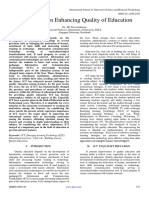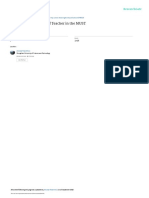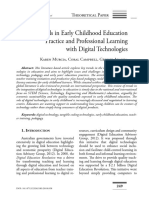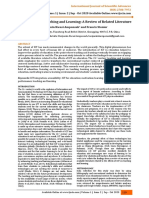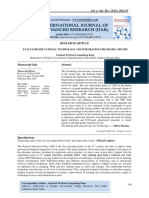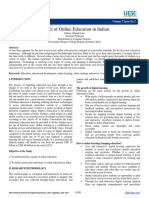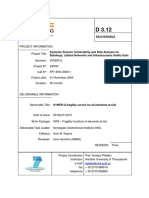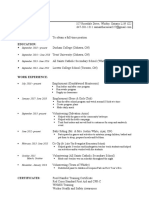SSRN Id3377617
SSRN Id3377617
Uploaded by
Shahbaz SikandarCopyright:
Available Formats
SSRN Id3377617
SSRN Id3377617
Uploaded by
Shahbaz SikandarOriginal Description:
Original Title
Copyright
Available Formats
Share this document
Did you find this document useful?
Is this content inappropriate?
Copyright:
Available Formats
SSRN Id3377617
SSRN Id3377617
Uploaded by
Shahbaz SikandarCopyright:
Available Formats
Available in the SSRN eLibrary: http://ssrn.com/link/2019-Int-Conf-ICDP.
html Education Research Network (EduRN)
IMPACT OF ICT IN EDUCATION: STUDENTS’ PERSPECTIVE
MANUSCRIPT T RACK: DIGITAL TECHNOLOGIES IN TEACHING
Nidhi Phutela * (Symbiosis Centre for Management Studies, Noida),
Sunita Dwivedi (Symbiosis Centre for Management Studies, Noida
Abstract:
ICT brought waves of industry transformations, which is also visible in education industry. With
the changing environment and the industry demand, student’s perspective towards learning is also
changing at a fast pace. Gone are the days when teachers used to merely teach through
blackboards in a lecture hall. The scenario is no more visible these days. ICT in education is
being used to enhance creativity, interaction and knowledge sharing apart from student learning.
But, the question is whether e-learning environment is able to achieve these objectives? This paper
will try to uncover how e-learning is giving a new shape to the education industry. Also, it will
encompass the students’ perspective and experience of e-learning. The results reveal that
government is taking many initiatives for developing and improving this platform. Despite the
efforts by the Government, students are still not fully convinced with the potential benefits of e-
learning. Furthermore, these platforms have confused the students regarding which one should
they opt for. Based on these findings, the authors have developed managerial implications for the
educators, students as well as educational institutions.
Keywords:
E-Learning, Educators, Education industry, ICT, Students Perspective
*Corresponding Author Email: nidiphutela@gmail.com Phone:9711107679
I. INTRODUCTION this is not the only approach used these days. The
inclusion of ‘Quality Education’ as a key
ICT brought waves of industry transformations,
sustainable development goal has led to the
which is also visible in education industry. The
expansion of the education sector globally
transformation of Indian industries is visible since
(Pothula, 2018)[4]. ICT in education is being used
the last two decades. The increased worldwide
to enhance creativity, interaction and knowledge
exposure has enhanced the competitiveness of the
sharing apart from student learning. To achieve all
firms in context of product or service delivery. ICT
the above objectives, Government of India
is getting key component of every industry and
introduced centrally sponsored schemes like
education industry is not an exception to it.
Educational Technology (ET) and Computer
Education sector is also equally inspired by the
Literacy and Studies in Schools (CLASS). ICT in
remarkable potential of information and
Education Curricula for students and teachers has
communication technology for upgrading the
been developed at the national level and being
quality of education along with outreach (MHRD
implemented across the country.
Policy, 2012)[1]. Owing to the advancement of
Likewise, e-Pathshala is developed by NCERT for
technology as well as the mentality of the people;
showcasing and disseminating all educational e-
Indian education system is evolving in many ways
resources. A major breakthrough by the Indian
(Jain, 2017)[2]. With the changing environment
Government includes the introduction of
and the industry demand, student’s perspective
SWAYAM. It provides an integrated platform for
towards learning is also changing at a fast pace.
online courses, using ICT that covers all higher
Focus area of ICT Policy is the participation of
education subjects and skill sector courses to
youth in the growth of knowledge society,
ensure the provision of the best quality higher
promoting the co-creation of quality content and
education at affordable cost. Apart from this,
developing networks between different
National Digital Library of India (NDL), a virtual
stakeholders. Technavio analysts report (2018)[3]
repository of learning resources has been created
revealed that the key factor that has contributed to
for wider accessibility of books (in the form of e-
the growth of e-learning market in India is the
books) (Press Release by MHRD, December 17,
increased penetration of internet and smart phones.
2018)[5].
Gone are the days when teachers used to merely
teach through blackboards in a lecture hall. But,
ICDP 2019: INTERNATIONAL CONFERENCE ON DIGITAL PEDAGOGIES 1
ELECTRONIC COPY AVAILABLE AT: https://ssrn.com/abstract=#######
Electronic copy available at: https://ssrn.com/abstract=3377617
Available in the SSRN eLibrary: http://ssrn.com/link/2019-Int-Conf-ICDP.html Education Research Network (EduRN)
ICT is increasingly used by the educational developing and improving this platform. Despite
institutions as an aid to teach students. Information the efforts by the Government, students are still not
technology has enabled and mediated resources for fully convinced with the potential benefits of e-
teaching and learning. IT has leveraged the learning. Furthermore, these platforms have
dissemination of information of sparse educational confused the students regarding which one should
resources for widespread availability or reach. they opt for. Based on these findings, the authors
Teachers are using this technology to make the have developed managerial implications for the
class interesting with giving some practical insights educators, students as well as educational
on one hand, while students use it to gain an in- institutions.
depth knowledge of the subject where they have
II. METHODOLOGY
interest on the other hand.
The present study employed Interpretative
E-Learning has gained popularity amongst the
Phenomenological Analysis (IPA) to intensely
students in India as it has brought a paradigm shift
scrutinize the lived in experiences of the
in their lives. Besides sharpening the skills of the
participants (Eatough & Smith, 2008; Smith, 1996,
students, it provides the comfort of anytime,
2004, 2011; Pringle et al., 2011)[7-11]. IPA is a
anywhere learning. ICT has opened new career
qualitative technique which is specifically used for
opportunities for students who are driven to explore
those studies where typical quantitative studies in
and learn – at their own pace and time. There is an
the discipline attempt to examine a smaller sample
increasing affinity of students for new technologies
of respondents in depth using, for example, semi-
and products as there is a huge potential for
structured interviews (Smith, 1996)[8]. It helps the
technology to be integrated into education industry.
investigator gain insights in depth and provides a
Students are embracing ‘self-learning’ through e-
clear understanding of the participants’ perceptions.
learning teaching models which act as a significant
As referred by, Dipboye & Foster (2002)[12], it
communication bridge between students and
provides better description and hence draws
teachers. Studies reveal that the creative use of
meaningful specified conclusions based upon pre-
Information and Communications Technology in
existing theories and concepts.
education has the capacity to increase the quality of
The determination of sample size is critical and due
people’s lives by enhancing teaching and learning
care should be taken while selecting participants
(Goyal, 2017)[6]. It recognizes the child’s
for this type of study to gain meaningful data. The
cognitive, social and emotional development
studies based on IPA can be conducted with a
significantly. Moreover, it extends the child’s
sample size ranging from one to 15 or more (Smith
immediate learning environment, offering
& Osborn, 2008)[13]. In the present study, the
incredible opportunities to push learning beyond
respondents were selected from Delhi NCR of
the confines of the classroom.
India. Semi-structured interviews were conducted
Teachers, nowadays, do not only deliver lectures to
to collect the primary data to understand the
the students; rather they facilitate in the provision
student’s perspectives on Impact of ICT in
of an e-learning environment by incorporating new
Education industry. The fifteen respondents (6
age digital media technologies while doing so. It
Females and 9 Males) showed their interest and
has thereby increased the scope of interactivity.
volunteered to be a part of the study with age
Digital platforms have resolved many issues like
ranging from 18-25 years. Most of the respondents
boredom, monotony, usage of same traditional
were unmarried. Three respondents were post-
pedagogy and lack of teachers for specialized
graduates, seven were pursuing graduation while
subjects thereby paving way for the best e-learning
another five were pursuing post-graduation.
experience through the flavor of independence in
their learning style. But, the question is whether e-
III. DATA COLLECTION & ANALYSIS
learning environment is able to achieve these
objectives? For the purpose of this research, primary data has
This paper will try to uncover how e-learning is been collected with the help of semi-structured
giving a new shape to the education industry. Also, interviews to gain in-depth insights from the
it will encompass the students’ perspective and respondents. The researchers used an open-ended
experience of e-learning. The results reveal that guide while conducting interviews. The reliability
government is taking many initiatives for and validity of the checklist was verified by four
ICDP 2019: INTERNATIONAL CONFERENCE ON DIGITAL PEDAGOGIES 2
ELECTRONIC COPY AVAILABLE AT: https://ssrn.com/abstract=#######
Electronic copy available at: https://ssrn.com/abstract=3377617
Available in the SSRN eLibrary: http://ssrn.com/link/2019-Int-Conf-ICDP.html Education Research Network (EduRN)
experts in the field and due modifications were The researchers have tried to capture the data of the
incorporated as per the given suggestions. To current research through the analysis of three
further test the construct validity, the revised draft different situations, which are detailed below.
with suggested changes was given to four students
IV. RESULTS AND DISCUSSION
who were not included in the study.
This section presents the findings from the analysis
In the first phase, followed by demographic details;
of fifteen interviews using Interpretative
two trigger questions were asked to the participants
Phenomenological Analysis. The findings have
- “What do you feel about online leaning courses?”
been grouped under two sections referred as
“What are the motivators that drive you to e-
‘themes,’ which includes ‘drivers for e-learning
learning? “What challenges do you think reduce the
adoption’ and ‘inhibitors which restrict the
interest in e-learning?” Questions asked by the
adoption of e-learning’.
researcher were simple and clear to avoid any
ambiguity. The average time duration of each
Situation 1
interview was forty-five minutes, though the
It was 2:00pm and Dr. Smitha, a finance faculty,
overall timings of the interviews fluctuated
was delivering a lecture in a management college.
between thirty five to eighty minutes.
The students were least interested as they were
Data as the whole was analyzed with the help of feeling sleepy. The teacher tried a lot to generate
ATLAS.ti version 8. As recommended by Smith & interest, but it was of no use. On being asked by the
Osborn (2008)[13], the current research work teacher the students replied, why don’t you make
followed the steps for analyzing interview data. the class interesting as we see in online courses?
The verbatim transcripts were closely read for Why are we still following the same old pedagogy
identification of essential themes, issues, and that we used to follow decades back? What if, we
expressions that provided meaningful insights into want to know more about this topic? Do you think
each participant’s outlook on e-learning. In the all related information will be available in a book?
second phase, the notes prepared were examined The teacher was taken aback with all these
for themes emerging and were marked up on the questions. She realized that she has to update
transcripts. Later, identified themes were recorded herself if she wants to stay in this profession. The
separately to the transcript and list of themes demands of the students have changed, so she has
emerged were analyzed for associations-checking to also change her pedagogies.
for similarities and differences between them and
forming clusters of the theme. Similar themes were The responses received from the respondents were
placed together and given terminology. The as follows:
researchers coded independently and validated the
E-learning makes use of interactive technologies to
entire process with internal consistency amongst enhance the learning experience’ (Respondent 2).
them was eighty percent. Each interview was ‘Education through online platform is more or less
analyzed from the transcript notes which were like an interactive text book’ (Respondent 5).
converted to themes and thereby clusters leading to ‘I believe visuals, apart from holding the attention
high order themes. The ‘cutting and sorting’ of the student, help in retaining the content for
technique suggested by Ryan &Bernard (2000)[14], longer period’ (Respondent 10).
‘I believe that e-learning breaks monotony from the
to ensure objectivity and transparency of the
regular study pattern. It is visually appealing &
analysis process. The results obtained were further interactive’ (Respondent 12).
deliberated till consistency is achieved. Further ‘The use of technology helps enhance the
authentication is confirmed by supporting understanding and the knowledge part of the
outcomes with verbatim excerpts from interview concepts’ (Respondent3)
participants. As suggested by Smith (2011)[10], ‘E-learning helps in diving and exploiting more
excerpts from three to four respondents per theme resources other than textbooks to impart knowledge
and content’ (Respondent 13).
are sufficient for sample size bigger than eight. To
‘Being a Marketing student myself, the digitized
maintain the word count, the perspective of every
aspect of it is taught with great extensity and detail,
individual participant was not detailed; although
it makes it that much more logical to use such aids
aspects of all individuals and themes were
for learning the same’ (Respondent 14).
identified across the entire group.
ICDP 2019: INTERNATIONAL CONFERENCE ON DIGITAL PEDAGOGIES 3
ELECTRONIC COPY AVAILABLE AT: https://ssrn.com/abstract=#######
Electronic copy available at: https://ssrn.com/abstract=3377617
Available in the SSRN eLibrary: http://ssrn.com/link/2019-Int-Conf-ICDP.html Education Research Network (EduRN)
Situation 2 problem with the security of these online resources,
Simran, a B.Tech. student, was very excited for the authenticity of the effort put by the student is
being placed in a good and reputed company with doubtful as anyone can complete the same for
a decent package. Her parents had financed her him/her’ (Respondent 10).
education through bank loan. She didn’t want to
put an extra financial burden on her parents for Situation 3
getting more certifications to securing a good job. Pooja, a mother of second year student Parth; was
She was in a dilemma as to what she should do. worried about his future. The reason for her
Because she wanted to get more certifications and tension was his phone on which he was glued 24 x
knowledge for the course, as whatever was taught 7. She complained that Parth was a fun loving child
in the college was basic and the companies who and an extrovert. But, within a span of just one
came for placements were expecting more from the year, his nature has changed a lot. He is just busy
students. Also, she wanted to distinguish herself in playing games or chatting with his friends or just
from the rest. She looked forward to e-learning scrolling the social media platforms whenever you
where she can earn few certifications with in-depth see him. He has stopped going out with his friends
quality knowledge at no cost. Amongst the pool of and started staying alone. He doesn’t even go for
resources, it was a tough decision for selecting an outing with the family. All he need is his phone or
optimal solution. laptop. She claimed that excessive use of
technology can be more or less similar to the drug
The respondents shared their opinions for the above addiction.
mentioned situation:
The viewpoint of the respondents were as follows:
‘E-learning has always been very helpful for me...I
was able to secure both the jobs by going through
‘Yes, its excessive usage can inculcate addictive
the courses online and whenever I am in doubt I
behavior’ (Respondent 5).
would try to find a YouTube video for that concept
‘However, during the process we get addicted to
and was able to clarify’ (Respondent 15).
the technology and become dependent on it, which
‘It helps in enhancing learner’s confidence which
becomes a challenge for us’ (Respondent 9).
can open good opportunities’ (Respondent 12).
‘There may be many fraud websites which can
‘It creates access to large number of people
charge a wholesome amount of money from
through easy connectivity. In short, it is leading
students and can give them false hope’
towards a better world through technology’
(Respondent 13).
(Respondent 1).
‘Exposes students & their personal information to
‘The convenience of E-learning makes it accessible
the big ocean of the world wide web which may be
to everyone from anywhere they want at any time,
dangerous to their privacy’ (Respondent 15).
this flexibility promotes learning 24x7’
‘You don't have a physical presence to guide you
(Respondent 3).
through the stuff hence the lack of motivation to
‘The solutions provided are fully accessed and can
complete the learning’ (Respondent 2).
be trusted’ (Respondent 4).
‘The Indian education system has been built on the
‘The biggest advantage of e-learning is the
fundamentals of a classroom, student-teacher
accessibility of the content on the go. You don't
interaction with the assistance of blackboard and
have to labor to find the content as its on your
chalks. This change in today’s day and age is
fingertips’ (Respondent 7).
imperative and destined to happen, but it all boils
‘E-learning is a cost-effective learning solution that
down to the right balance’ (Respondent 8).
transcends time and distance’ (Respondent 6).
‘Students who don't go to coaching or tuitions can
learn through e-learning by sitting at their home V. ANALYSIS AND INTERPRETATION
and without putting much efforts and money. This
proves to be very beneficial for a country like ours E-learning is an innovation, which has drastically
where there's a lot of poverty and if somehow every impacted the way of learning and teaching as well.
student gets connected with internet and e While analyzing the responses, the researchers
learning websites, in no big Time India will see a analyzed that there are certain factors which
vast difference in its education sector’ (Respondent motivate the students to adopt e-learning while
9). there are certain inhibitors which restrict the
‘You don’t have to spend much for gaining an adoption of e-learning amongst students. As
extra knowledge!’ (Respondent 11) identified by the researchers, the key factors which
‘As this model is at a developing stage, there is a impact e-learning are:
ICDP 2019: INTERNATIONAL CONFERENCE ON DIGITAL PEDAGOGIES 4
ELECTRONIC COPY AVAILABLE AT: https://ssrn.com/abstract=#######
Electronic copy available at: https://ssrn.com/abstract=3377617
Available in the SSRN eLibrary: http://ssrn.com/link/2019-Int-Conf-ICDP.html Education Research Network (EduRN)
• Most of the students are motivated to adopt e- access to internet. They lose interest when given
learning or engage themselves in courses through a chance to surf net. Almost everyone has a smart
online education due to the ease in access of phone and a laptop along with internet
online courses. It’s just on touch of a button the connection. If left alone, they would be more
students can study or learn the courses of their prone to engagement in other activities like
interest. Students yearn for learning more, but gaming, watching movies or series which may
not at the cost of convenience. E-learning is a also give rise to potential health risks associated
very convenient and flexible option of training with excessive usage.
oneself not only on a day-to-day basis, but
• Students were of the opinion that even though e-
whenever one has free time to. It enables just-in-
learning is interactive, but still they feel that
time learning.
face-to-face interaction and the knowledge
• Students are eager to adopt courses through e-
sharing is a must for education which is missed
learning because they find it affordable. There
on virtual platform. Students shared that there is
are many online education portals that are
lack of motivation to study alone. They are
providing quality education free of cost, which is
tempted away from studying when they connect
a major attraction for the students. Many students
to the internet, hence may not be able to perform
adopt e-learning of some specialized courses
as well as they would do it in a traditional class.
parallel with their education (degree course) as it
is cost-effective with not much of a financial
VI DISCUSSIONS & CONCLUSION
burden.
• The students highlighted that they adopt e- India is emerging as a superpower and it cannot
learning because of its captive nature. The e- function without the support of ICT (Goyal,
learning content can capture the interest of 2017)[6]. During the investigation, the researchers’
participants because of the use of multimedia and recommended that technology should not drive
in some cases its interactive nature. Students education; rather, educational goals and needs must
were highly motivated to adopt e-learning due to drive technology use. Due care must be taken in
interactivity it creates and hence engage the developing e-learning content because students
audience for longer time duration. look forward for this as an opportunity to excel.
• The students also shared that it adds value to Merely providing ongoing e-learning courses for
their on-going courses or education and hence academics is insufficient; they expect some hands
increase the chance of employability. The on experience for better understanding of the
courses can be selected as per one’s choice and concepts. E-learning cannot by itself resolve
thereby knowledge can be enhanced without educational problems in the developing world.
even setting the limit. Itcan act as additional educational tools, if they are
• Students showed their inclination for e-learning used prudently, to raise the quality of education. E-
due to many reasons. But, the consideration of learning can be employed to give users quick
future opportunities was very much talked about. access to ideas and experiences from a wide range
Directly or indirectly their major concern for of people, communities and cultures to increase the
gaining knowledge was attached with future tangibility. Also, it encourages active and
prospects or building a good career. The students independent learning, self-responsibility and
discussed those e-learning acts as a support for maturity for learning. E- Learning is a relatively
carving their career. It helps in grooming their new concept in Indian education whether in
skills and enhancing their knowledge which schools, colleges or other academic institutions, but
ultimately provides employment opportunities. it has a huge potential in the next few years. With
• Students felt that one of the major causes of the integration of ICT in schools, education in India
disinterest in e-learning is data security. The is poised for a paradigm shift, where the education
student’s creativity is also at stake as it system will be compatible with international
encourages plagiarism. education standard (Jain, 2017)[2]. Technology has
entered in every domain of the society and
• Students were of the opinion that that they are embedding itself while providing advantages like –
not motivated to study alone. They are being faster and easier access to information, increased
tempted away from studying when they have an flexibility, affordability and many more. There are
ICDP 2019: INTERNATIONAL CONFERENCE ON DIGITAL PEDAGOGIES 5
ELECTRONIC COPY AVAILABLE AT: https://ssrn.com/abstract=#######
Electronic copy available at: https://ssrn.com/abstract=3377617
Available in the SSRN eLibrary: http://ssrn.com/link/2019-Int-Conf-ICDP.html Education Research Network (EduRN)
still few hurdles which make this ride a bit more psychology review, Vol.5 No. 1, pp.9-27.Author
Name, “Title of paper,” unpublished.
comfortable and smooth. For this, many bridges are
11. Pringle, J., Drummond, J., McLafferty, E., &
yet to be crossed like the confusion or clutter, tech- Hendry, C. (2011). Interpretative phenomenological
phobia, reliability, etc to name a few. Indeed, it is a analysis: a discussion and critique. Nurse researcher,
long term strategy and will take time for its 18(3), 20-25.
12. Dipboye, R.L. and Bigazzi Foster, J., (2002). Multi-
acceptability by the stakeholders. It is the
level theorizing about perceptions of organizational
researchers’ conviction that the systematic politics.In The many faces of multi-level issues (pp.
consideration of these factors will contribute in 255-270). Emerald Group Publishing Limited.
gearing up this industry as a whole. This can make 13. Smith, J.A. and Osborn, M., 2008.Interpretative
Phenomenological Analysis. Qualitative psychology:
e-learning the most effective way of learning in
a practical guide to research met hods. Smith JA,
today's scenario. It will be seen as a way of editors.
transforming the face of education in India. 14. Ryan, G. W., & Bernard, H. R. (2000).Techniques to
identify themes in qualitative data. Handbook of
REFERENCES Qualitative Research. 2nd ed. Thousand Oaks, CA:
Sage Publications.
1. National Policy on Information and Communication
Technology in School Education, by the Department
of School Education and Literacy , Ministry of Author Biographical Statements
Human Resource Development, Government of
India, 2012. Retrieved from: Dr Nidhi Phutela is working with
http://mhrd.gov.in/sites/upload_files/mhrd/files/uploa Symbiosis International University
d_document/revised_policy%20document%20ofICT. as an Assistant Professor. She is
pdf UGC-NET Qualified, M-
Phil (business management) &
2. Jain, R. (2017). How ICT is evolving Indian
MBA rank holder with approx 14
education system, The Education Post, Oct., 27. yrs of experience in teaching MBA
Retrieved from and CA students. She has worked
https://educationpostonline.in/2017/10/27/how-ict-is- on the editorial board of 4 journals.
evolving-indian-education-system/ She has to her credit many
3. Technavio Analyst report (2018). Online education publications in peer reviewed
market in India 2018-2022, Business Wire, Sep., 24. national & international journals as
well as chapters in edited books,
Retrieved from
authored one book and presented 7
https://www.businesswire.com/news/home/20180924 papers in International conferences
005589/en/Online-Education-Market-India-2018- including IIMs. She has conducted
2022-Emergence-Cloud several corporate training programs
4. Pothula, V. (2018). Emerging trends in Education and workshops in reputed
Sector in 2019, Digital Learning, Dec., 24. Retrieved universities. Her research interest
areas include: Services Marketing
from
& Digital Marketing.
https://digitallearning.eletsonline.com/2018/12/emer
ging-trends-in-education-sector-in-2019/
5. Press Information Bureau, Government of India,
Minitry of Human Resource Development. Retrieved Dr. Sunita Dwivedi is an
from: Associate Professor at Symbiosis
http://pib.nic.in/newsite/PrintRelease.aspx?relid=186 Centre for Management Studies-
NOIDA, having Academic
501
Exposure for more than 20 Years.
6. Goyal, V. (2017). ICT revolutionizes education in She has served many Prestigious
India, The education Post, Jun., 30. Retrieved from Universities and guided many
https://educationpostonline.in/2017/06/30/ict- national and international PhD
revolutionizes-education-in-india/ scholars under her flagship. Her
7. Eatough, V. and Smith, J.A., (2008), Interpretative research area is Marketing, HRM,
phenomenological analysis. The Sage handbook of Advertising and Consumer
Behavior. She has more than 20
qualitative research in psychology, 179, pp.194
research publications in various
8. Smith, J.A., (1996) “Beyond the divide between renowned journals and edited
cognition and discourse: Using interpretative books.
phenomenological analysis in health psychology”,
Psychology and health, Vol.11, No.2, pp.261- 271.
9. Smith, J.A., (2004), “Reflecting on the development
of interpretative phenomenological analysis and its
contribution to qualitative research in psychology”,
Qualitative research in psychology, Vol.1 No.1,
pp.39-54
10. Smith, J.A., (2011), “Evaluating the contribution of
interpretative phenomenological analysis”, Health
ICDP 2019: INTERNATIONAL CONFERENCE ON DIGITAL PEDAGOGIES 6
ELECTRONIC COPY AVAILABLE AT: https://ssrn.com/abstract=#######
Electronic copy available at: https://ssrn.com/abstract=3377617
You might also like
- SITHKOP012 AT1 Research Report.Document22 pagesSITHKOP012 AT1 Research Report.Prabina Bajracharya100% (1)
- Simplex ES Touch Screen Display Launch Technical PresentationDocument29 pagesSimplex ES Touch Screen Display Launch Technical PresentationEng. Ahmed TahaNo ratings yet
- Effects of Computer Usage On Students PerformanceDocument18 pagesEffects of Computer Usage On Students PerformanceAbdul-Fatawu Ibn Ibrahim Doctah67% (3)
- Assessing The Impact of Information Communication Technology ICT in The Teaching and Learning of Social Studies in Senior High Schools in Ghana A Case of Eastern Region SchoolsDocument25 pagesAssessing The Impact of Information Communication Technology ICT in The Teaching and Learning of Social Studies in Senior High Schools in Ghana A Case of Eastern Region SchoolsEditor IJTSRDNo ratings yet
- Role of ICT On Enhancing Quality of EducationDocument3 pagesRole of ICT On Enhancing Quality of EducationInternational Journal of Innovative Science and Research TechnologyNo ratings yet
- ICT Competency Level of Teacher in The MUST: September 2017Document6 pagesICT Competency Level of Teacher in The MUST: September 2017Dino DizonNo ratings yet
- Applications of Ict To Enhancing Basic Education in NigeriaDocument4 pagesApplications of Ict To Enhancing Basic Education in NigeriaopepolawalNo ratings yet
- ICT Enabled Teacher Training For Human Capital Formation: A Study of IIT Bombay InitiativeDocument26 pagesICT Enabled Teacher Training For Human Capital Formation: A Study of IIT Bombay InitiativeAbhilash TnNo ratings yet
- Strategies and Action Plans For Integrating ICT Into Saudi Elementary Schools Curricula - The Case of Tabuk District of EducationDocument8 pagesStrategies and Action Plans For Integrating ICT Into Saudi Elementary Schools Curricula - The Case of Tabuk District of EducationwarrenNo ratings yet
- Theoritecal Article About Introducing Digital Learning N Earlycholhood 2017 AustraliaDocument16 pagesTheoritecal Article About Introducing Digital Learning N Earlycholhood 2017 AustraliaJordi BirostaNo ratings yet
- ProposalDocument17 pagesProposalSandra EladNo ratings yet
- Conceptual Model To Predict Filipino Teachers 2Document16 pagesConceptual Model To Predict Filipino Teachers 2Lukwago UmaruNo ratings yet
- Arvind Kumar GillDocument10 pagesArvind Kumar GillINTERNATIONAL JOURNAL FOR EDUCATIONAL RESEARCH STUDIESNo ratings yet
- Ict in Teacher Education Programme: Issn: Vol. Issue - 2018Document7 pagesIct in Teacher Education Programme: Issn: Vol. Issue - 2018FARHA HASANNo ratings yet
- ArticleDocument5 pagesArticleJashlyn MirandaNo ratings yet
- Hyper Content E-Module in Information Behavior Course With The Assistant of ScreencastDocument9 pagesHyper Content E-Module in Information Behavior Course With The Assistant of ScreencastJournal of Education and LearningNo ratings yet
- EJ1335793Document11 pagesEJ1335793josephine tagupaNo ratings yet
- Constraint To Effective Use of ICT On Islamic Education A Critical Analysis of Public and Private Secondary SchoolDocument7 pagesConstraint To Effective Use of ICT On Islamic Education A Critical Analysis of Public and Private Secondary SchoolEditor IJTSRDNo ratings yet
- Information Communication Technology AppraisalDocument8 pagesInformation Communication Technology AppraisalInternational Journal of Innovative Science and Research TechnologyNo ratings yet
- Icts in Learning in Pakistan: September 2012Document14 pagesIcts in Learning in Pakistan: September 2012ali raajNo ratings yet
- Concept PaperDocument15 pagesConcept PaperElla Blanca BuyaNo ratings yet
- Impact of ICT On Teaching-3068Document8 pagesImpact of ICT On Teaching-3068Kevin RajNo ratings yet
- Leverage Points For Effective E-Learning Implementation in Developing Country Contexts Using A Systems Thinking ApproachDocument11 pagesLeverage Points For Effective E-Learning Implementation in Developing Country Contexts Using A Systems Thinking ApproachAnonymous izrFWiQNo ratings yet
- Importance of Ict in LearningDocument9 pagesImportance of Ict in LearningAnonymous CwJeBCAXpNo ratings yet
- Innovations in Higher Education For Teaching and Learning Using TechnologyDocument3 pagesInnovations in Higher Education For Teaching and Learning Using TechnologyEditor IJTSRDNo ratings yet
- ICT IN HIGHER EDUCATION - Review PDFDocument12 pagesICT IN HIGHER EDUCATION - Review PDFLovish RahejaNo ratings yet
- Article4 PDFDocument20 pagesArticle4 PDFMickle jay PaccialNo ratings yet
- Evaluated Educational Technology and Integration Strategies: Nep 2020Document7 pagesEvaluated Educational Technology and Integration Strategies: Nep 2020IJAR JOURNALNo ratings yet
- FEdTech-Wk1. What Is ICTDocument9 pagesFEdTech-Wk1. What Is ICT09050479898No ratings yet
- A-Study-On-Feasibility-And-Effectiveness-Of-ICT-Integration-In-Higher-Education-In-Developing-CountriesDocument4 pagesA-Study-On-Feasibility-And-Effectiveness-Of-ICT-Integration-In-Higher-Education-In-Developing-CountriesjamesandrieprovidaNo ratings yet
- SSRN Id3429541Document4 pagesSSRN Id3429541Salma CHAKROUNENo ratings yet
- 30 Trishala BhaskarDocument7 pages30 Trishala BhaskarAnonymous CwJeBCAXpNo ratings yet
- (Gideon) ICT APPLICATION AND ITS USE IN BUSINESS EDUCATION COURSES FOR TEACHING AND LEARNINGDocument56 pages(Gideon) ICT APPLICATION AND ITS USE IN BUSINESS EDUCATION COURSES FOR TEACHING AND LEARNINGgreatbachelintNo ratings yet
- APJMR 2014-2-164 Preparedness and Attitude of College Students Toward ICT BasedDocument8 pagesAPJMR 2014-2-164 Preparedness and Attitude of College Students Toward ICT BasedAsia Pacific Journal of Multidisciplinary ResearchNo ratings yet
- Dr. Pardeep Thakral (VED PRAKASH 2)Document5 pagesDr. Pardeep Thakral (VED PRAKASH 2)INTERNATIONAL JOURNAL FOR EDUCATIONAL RESEARCH STUDIESNo ratings yet
- 921-Article Text-1585-1-10-20240531Document15 pages921-Article Text-1585-1-10-20240531As AsNo ratings yet
- Impact of Online Education in IndianDocument3 pagesImpact of Online Education in Indianarcha agrawalNo ratings yet
- E-Learning Roadmap For Open Distance Learning in CDocument8 pagesE-Learning Roadmap For Open Distance Learning in CKristian Karl Bautista Kiw-isNo ratings yet
- Role of ICT in Higher EducationDocument5 pagesRole of ICT in Higher EducationregalNo ratings yet
- The Role and Importance of Information and Communication Technology in The Management of Professional Educational Institutions in IndiaDocument8 pagesThe Role and Importance of Information and Communication Technology in The Management of Professional Educational Institutions in Indiabmerf indiaNo ratings yet
- Research Into ICT Integration in Pakistan Secondaaary SchoolsDocument11 pagesResearch Into ICT Integration in Pakistan Secondaaary SchoolsKeshawn PaulNo ratings yet
- Implementation of Active Learning For ICT Education in SchoolsDocument5 pagesImplementation of Active Learning For ICT Education in SchoolsInternational Journal of Innovative Science and Research TechnologyNo ratings yet
- Humnaities Application PINKAL CHAUDHARIDocument10 pagesHumnaities Application PINKAL CHAUDHARIBESTJournalsNo ratings yet
- 9IJELS JAN 2018 10 EdmodoMultimedia2Document10 pages9IJELS JAN 2018 10 EdmodoMultimedia2Fira FeronicaNo ratings yet
- The Development and Policies of ICT Supporting Educational Technology in Singapore, Thailand, Indonesia, and MyanmarDocument8 pagesThe Development and Policies of ICT Supporting Educational Technology in Singapore, Thailand, Indonesia, and MyanmarInternational Journal of Evaluation and Research in Education (IJERE)No ratings yet
- ICT As A Catalyst For Teaching-Learning Process: A Meta-Analysis StudyDocument5 pagesICT As A Catalyst For Teaching-Learning Process: A Meta-Analysis Studyoluwatobiloba mayowaNo ratings yet
- Development and Evaluation of Techno-Mediated Creative Writing Enhancement Activities For Grade 12 StudentsDocument12 pagesDevelopment and Evaluation of Techno-Mediated Creative Writing Enhancement Activities For Grade 12 StudentsPsychology and Education: A Multidisciplinary JournalNo ratings yet
- 3 PBDocument8 pages3 PBalfrialjasalNo ratings yet
- REVISED Thesis 2 FinalsDocument82 pagesREVISED Thesis 2 FinalsJaira GaanoNo ratings yet
- Barriers To The Introduction of IctDocument20 pagesBarriers To The Introduction of IctBashir Ali Sidi JuhaNo ratings yet
- Ieee Paper StudynotionDocument9 pagesIeee Paper StudynotionlartzyjamesNo ratings yet
- ICT Integration in Teaching and Learning in Second PDFDocument5 pagesICT Integration in Teaching and Learning in Second PDFJay P. MacedaNo ratings yet
- Ireland Case Study: EDTC 645Document8 pagesIreland Case Study: EDTC 645api-400990840No ratings yet
- UNESCO - Leveraging Education Through Technology Experiences and Lessons From The Education University of Hong Kong, ChinaDocument16 pagesUNESCO - Leveraging Education Through Technology Experiences and Lessons From The Education University of Hong Kong, ChinaAceNo ratings yet
- ICT and Commerce TeachingDocument2 pagesICT and Commerce TeachingRitu ChakravartyNo ratings yet
- Arushi IT projectDocument5 pagesArushi IT projectDhruvi MaheraNo ratings yet
- 1246 JR329Document9 pages1246 JR329Irsyad Nugraha, M.Pd.No ratings yet
- Educators' Perspectives About Ict Enabled TeachingDocument13 pagesEducators' Perspectives About Ict Enabled TeachingGlobal Research and Development ServicesNo ratings yet
- Building Towards A Learning Society A National Digital Strategy For Schools Consultative PaperDocument15 pagesBuilding Towards A Learning Society A National Digital Strategy For Schools Consultative PaperWilliamNo ratings yet
- The Edutech Segment - Opportunities and GrowthDocument2 pagesThe Edutech Segment - Opportunities and GrowthGANGATHARAN MNo ratings yet
- Teaching and Learning in Technology Empowered Classrooms—Issues, Contexts and PracticesFrom EverandTeaching and Learning in Technology Empowered Classrooms—Issues, Contexts and PracticesNo ratings yet
- Lab Equipment: Erlenmeyer Flask Florence FlaskDocument10 pagesLab Equipment: Erlenmeyer Flask Florence FlaskAlthea ValenzuelaNo ratings yet
- Civil Service Commission Professional or Sub DwawdawdawdreviewerDocument99 pagesCivil Service Commission Professional or Sub DwawdawdawdreviewerHarey PatarNo ratings yet
- Ajm 7 3 013Document17 pagesAjm 7 3 013Arvind UbaleNo ratings yet
- DLP. 21ST CENTURY LIT - Week-8 CONTEXT AND ITS TYPEDocument4 pagesDLP. 21ST CENTURY LIT - Week-8 CONTEXT AND ITS TYPEMichelle ManzanoNo ratings yet
- D3.12 - SYNER-G Fragility Curves For All Elements at RiskDocument145 pagesD3.12 - SYNER-G Fragility Curves For All Elements at RiskMohammad AL HaririNo ratings yet
- Transfer 2Document29 pagesTransfer 2DIGITAL SEVANo ratings yet
- Abhijit Dhar - CV1Document2 pagesAbhijit Dhar - CV1Abhijit PhoenixNo ratings yet
- The Integrating A/D Converter (ICL7135) : Application Note February 1999Document5 pagesThe Integrating A/D Converter (ICL7135) : Application Note February 1999ytnateNo ratings yet
- Anodizing ProcedureDocument4 pagesAnodizing ProcedureGoran TesicNo ratings yet
- Engleski Za Ostale Profile Literatura I Model Testa 1Document7 pagesEngleski Za Ostale Profile Literatura I Model Testa 1overtimemoreovertimeNo ratings yet
- L3b Reactor Sizing Example ProblemsDocument15 pagesL3b Reactor Sizing Example ProblemsNaniNeijieNo ratings yet
- What Is Emotional IntelligenceDocument2 pagesWhat Is Emotional IntelligenceNuzhat TabassumNo ratings yet
- Political Response To Capitalist Crisis Neo-Marxist Theories of The State and The Case of The New DealDocument47 pagesPolitical Response To Capitalist Crisis Neo-Marxist Theories of The State and The Case of The New DealjauncitoNo ratings yet
- Wolverine Reading OrderDocument2 pagesWolverine Reading OrderTomasHamNo ratings yet
- Grade 8Document30 pagesGrade 8Ma Princess MadiaNo ratings yet
- Permutation and Combination: Name - Tuhin Nayak Class - XI A' Roll No. - 29Document8 pagesPermutation and Combination: Name - Tuhin Nayak Class - XI A' Roll No. - 29Tuhin NayakNo ratings yet
- 656-fc 2636Document3 pages656-fc 2636Arturo castellonNo ratings yet
- Texas Instruments' Bill Klein Signal Chain Basics ArticlesDocument2 pagesTexas Instruments' Bill Klein Signal Chain Basics ArticlesIonela100% (2)
- Lectures of American LiteratureDocument9 pagesLectures of American Literaturemeriem18No ratings yet
- Bursitis/Tendinitis: DR M Arman Nasution SPPDDocument197 pagesBursitis/Tendinitis: DR M Arman Nasution SPPDdiah stanyaNo ratings yet
- Chalet Book: Font Installation InstructionsDocument5 pagesChalet Book: Font Installation InstructionsRonaldNo ratings yet
- Outline EDU301 - General Methods of TeachingDocument3 pagesOutline EDU301 - General Methods of TeachingShahid HussainNo ratings yet
- Fertilizer and Soil Amendments HandbookDocument63 pagesFertilizer and Soil Amendments HandbookJitendra PankajNo ratings yet
- Samantha CassarDocument1 pageSamantha Cassarapi-506346106No ratings yet
- Comandos DatamineDocument32 pagesComandos DatamineDoktorMAN JassoNo ratings yet
- Comparison of Quantitatave and Qualitative ResearchDocument6 pagesComparison of Quantitatave and Qualitative Researchkristine collins YambaoNo ratings yet
- EM g7 Maths 2021 WP 3rdDocument10 pagesEM g7 Maths 2021 WP 3rdNikila WeerasingheNo ratings yet
- 1984 Tape Recording GuideDocument73 pages1984 Tape Recording Guidejdap2000-1100% (1)




